Data
We use a wide variety of datasets including phylogenetic, genomic and phenotypic trait data, often coupled with spatial and environmental data, as well as social data in the context of more applied research. Some of our main data sources, with examples of research outputs, are listed below.
AVONET database
We have spent the last two decades harvesting information on the life history, ecology and morphology of all 10,000+ bird species. Data are collated from field observations, primary and secondary literature, and through a network of collaborators working at over 70 museums and biological collections worldwide. The first iteration – AVONET 1.0 – has been released and we are working on the next phase of data compilation, focusing on traits useful in quantifying the ecological function of species.
See: Tobias, J.A. et al. (2022) AVONET: morphological, ecological and geographical data for all birds. Ecology Letters 25: 581-597. Read paper
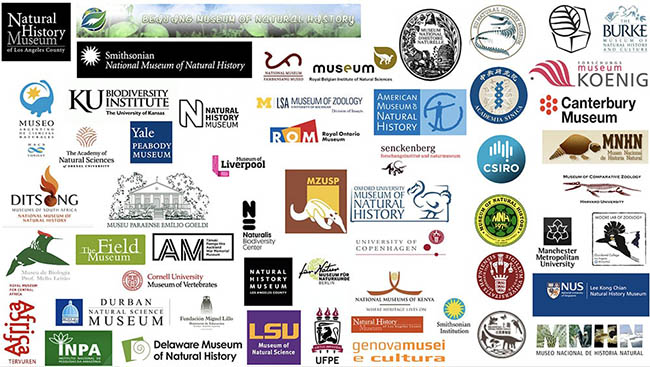
Signals and communication
We are interested in signal diversification and in particular the role of sexual selection and social competition in shaping animal communication and signalling behaviours. Our main interest is in understanding the evolution of visual and acoustic signals across the world’s birds, with a longstanding focus on song in passerines. This involves collecting a lot of structural data from sound files stored in digital archives such as Macaulay Library and www.xeno-canto.org.
Example: Tobias et al. (2014) Species coexistence and the dynamics of phenotypic evolution in adaptive radiation. Nature 506: 359–363. Read paper
Example: Tobias et al. (2016) Territoriality, social bonds, and the evolution of communal signaling in birds. Frontiers in Ecology & Evolution 4: 74. Read paper
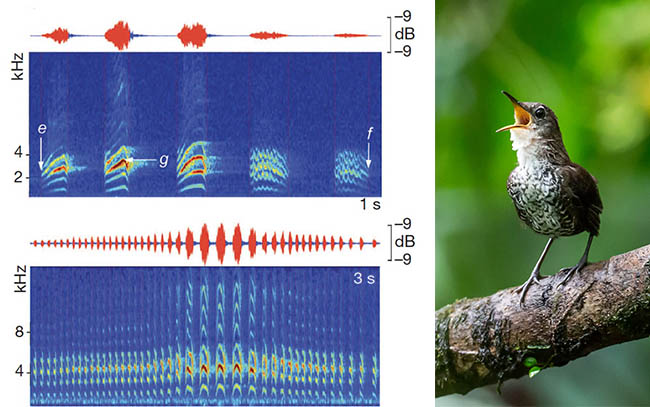 The acoustic structure and complexity of birdsong can be measured in fine detail using sonograms
The acoustic structure and complexity of birdsong can be measured in fine detail using sonograms
Morphology
Our research showing how morphological traits map onto ecological niches is providing a new framework for research on the structure and function of ecosystems.
Example: Bregman et al. (2016) Using avian functional traits to quantify the impact of land-cover change on ecosystem processes linked to resilience in tropical forests. Proc. R. Soc. B 283: 20161289. Read paper
Example: Pigot et al. (2020) Macroevolutionary convergence connects morphological form to ecological function in birds. Nature Ecology & Evolution 4: 230–239. Read paper
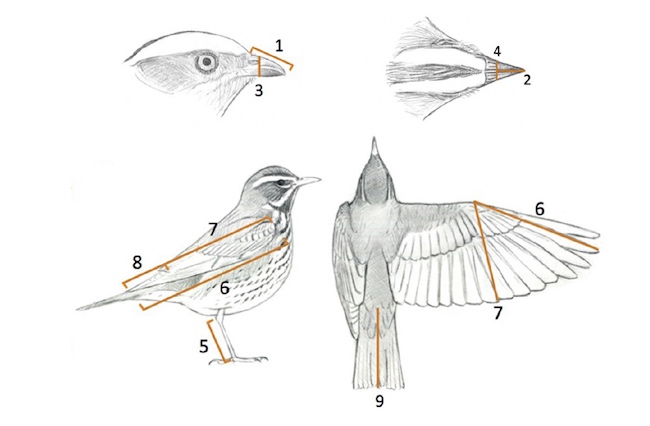 Standard morphometric measurements taken from live birds and museum specimens
Standard morphometric measurements taken from live birds and museum specimens
Dispersal
Dispersal and gene flow are fundamental inter-connected processes in ecology and evolutionary biology. To study variation in dispersal across species, and its effect on broad-scale patterns in biodiversity, we use the hand-wing index, an index of flight efficiency and dispersal ability.
Example: Pigot, A. & Tobias, J.A. (2015) Dispersal and the transition to sympatry in vertebrates. Proceedings of the Royal Society B 282: 20141929. Read paper
Example: Sheard, C. et al. (2020) Ecological drivers of global gradients in avian dispersal inferred from wing morphology. Nature Communications 11: 2463. Read paper
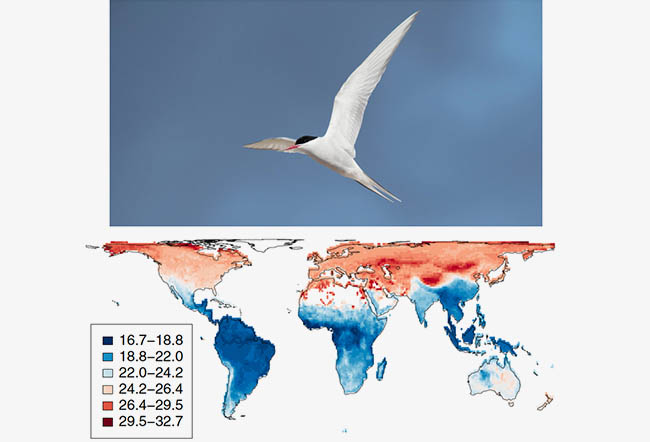 Avian dispersal ability varies with latitude, lower (blue) in the tropics and higher (red) towards the poles
Avian dispersal ability varies with latitude, lower (blue) in the tropics and higher (red) towards the poles
Behaviour
Behaviour is fundamental to many processes in ecology and yet is often overlooked in macroecological analyses. To explore its effects, we are quantifying sexual selection, territoriality, social behaviour, song and (in collaboration with Alex Pigot’s lab at UCL) foraging behaviour for the world’s birds.
Example: Tobias, J.A. et al. (2016) Territoriality, social bonds, and the evolution of communal signaling in birds. Frontiers in Ecology & Evolution. Read paper
Example: Freeman, B.G. et al. (2019) Behavior influences range limits and patterns of coexistence across an elevational gradient in tropical bird diversity. Ecography. Read paper
Example: Sol et al. (2020) The global impact of urbanisation on avian functional diversity. Ecology Letters. Read paper
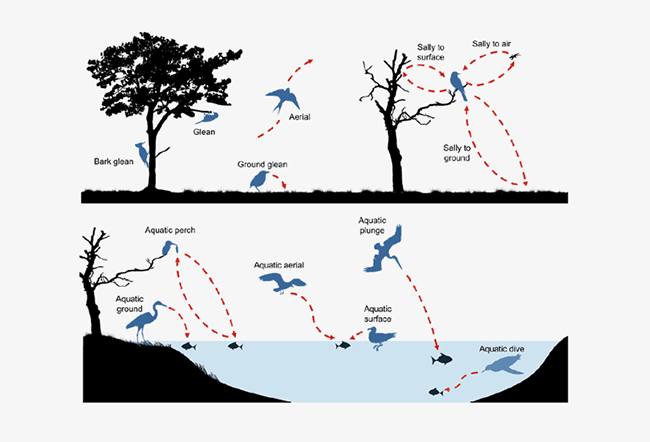 Behavioural dimensions of the trophic niche in birds (see Pigot et al. 2020, Sol et al. 2020)
Behavioural dimensions of the trophic niche in birds (see Pigot et al. 2020, Sol et al. 2020)
Trait-based interaction networks
To study trophic interactions, we are developing trait-based analyses of multi-trophic networks, including plant-animal interactions at the heart of ecosystem function.
Example: Pigot, A. et al. (2016) Quantifying species contributions to ecosystem processes: a global assessment of functional trait and phylogenetic metrics across avian seed-dispersal networks. Proceedings of the Royal Society B 283: 20161597. Read paper
Example: McFadden, I.R. et al. (2022) Global plant-frugivore trait matching is shaped by climate and biogeographic history. Ecology Letters 25: 686–696. Read paper
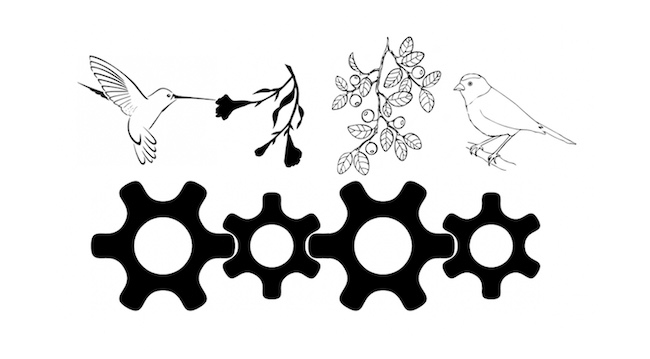 Darwin famously marvelled at the "tangled bank" made up of species "dependent upon each other in so complex a manner", their network of interactions depicted here as the cogs and wheels of ecosystem function
Darwin famously marvelled at the "tangled bank" made up of species "dependent upon each other in so complex a manner", their network of interactions depicted here as the cogs and wheels of ecosystem function
Socio-ecological Systems
Whether framed as “Natural Capital”, “Nature’s Contributions to People” or plain old “Ecosystem Services”, the importance of biodiversity to society can’t be understood except in the context of people’s needs and values. We are increasingly interested in addressing these questions in collaboration with social scientists and sustainable development agencies. For example, through projects like SENTINEL we are combining biodiversity research with data from trade-off analyses, village surveys and online questionnaires to explore more sustainable development pathways in Africa.
Example: Seddon, N. et al. (2016) Biodiversity in the Anthropocene: prospects and policy. Proceedings of the Royal Society B 283: 20162094. Read paper
Example: Echeverri, A. et al. (2019) Do avian functional traits predict cultural ecosystem services? People and Nature 2: 138–151. Read paper
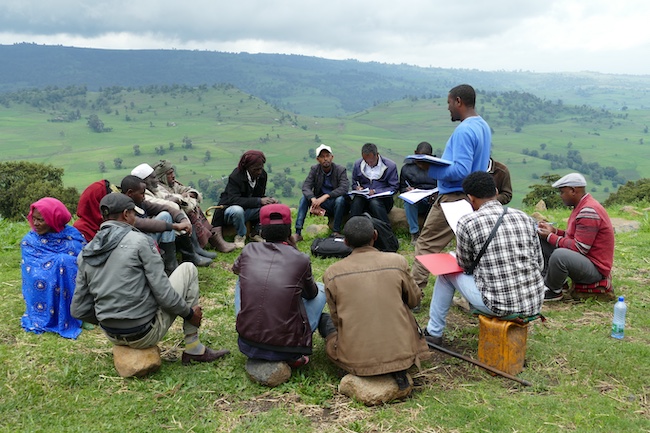 Surveying local views provides vital context for understanding trade-offs between agricultural development and environmental protection in sub-Saharan Africa
Surveying local views provides vital context for understanding trade-offs between agricultural development and environmental protection in sub-Saharan Africa
Data availability
We are committed to Open Science principles and will release all in-house data openly, linked from the Open Traits Network. Because of the size and complexity of some global datasets, often contributed by hundreds of researchers based at numerous institutions, the release of data will sometimes take place in a stepwise fashion. In general, we have to wait until relevant data papers or key analyses by lab members are released. In the meantime, write to us if you’d like to discuss data usage or collaborations. Whenever feasible, we always provide access to data on request.
See: Gallagher, R.V. et al. (2020) Open Science principles for accelerating trait-based science across the Tree of Life. Nature Ecology & Evolution 4: 294–303. Read paper